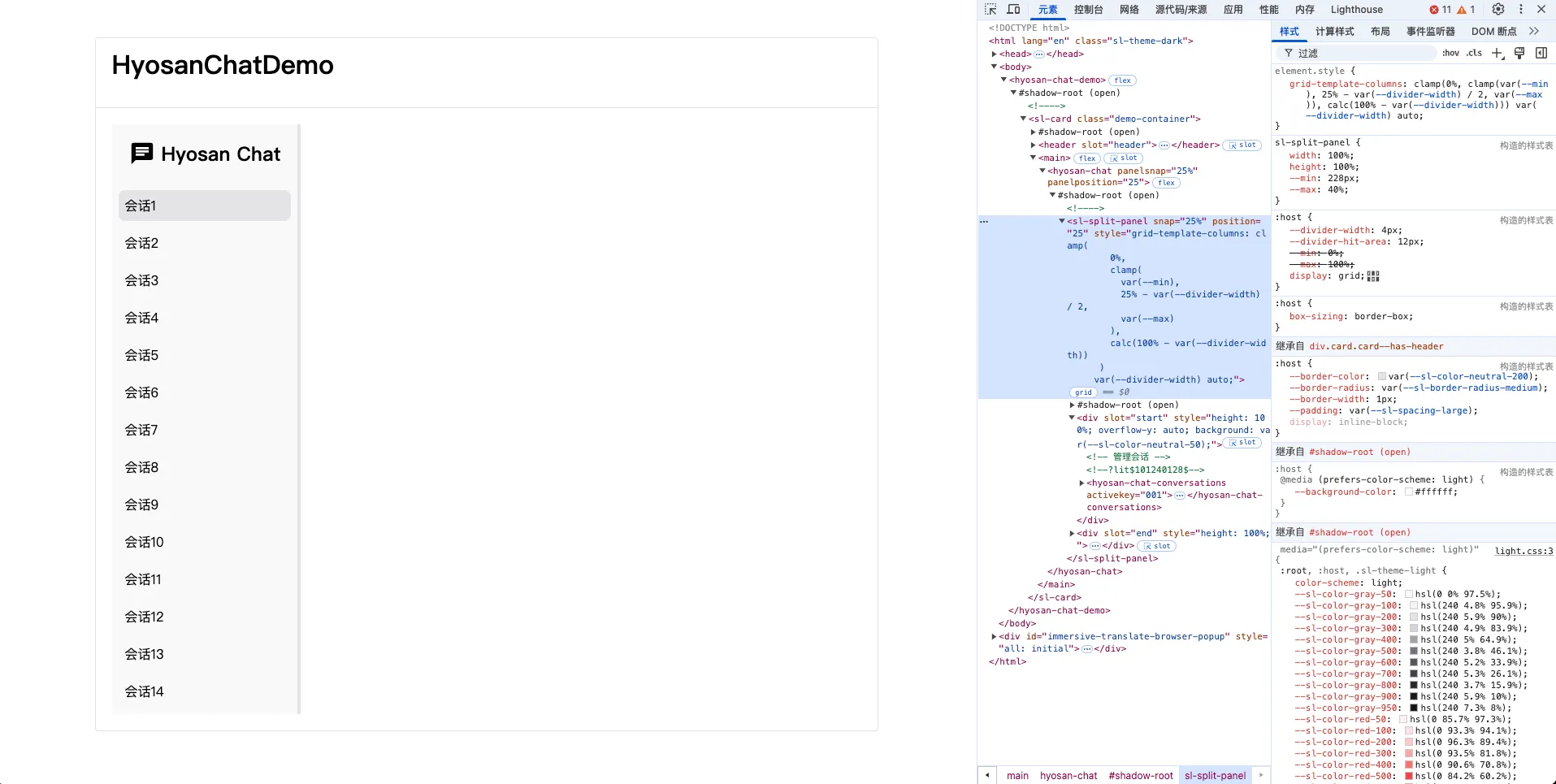前面我们从 Web Components 开始看起, 接着学习了 Lit, 然后开始搭建项目, 引入各种工程化依赖, 增加打包配置并进行了可行性测试, 始终没有涉及实际的功能, 是因为我希望能更全面的学习 Web Components, 组件库只是我们学习的最终成果, 成果固然重要, 但 学习不同的技术 / 翻阅文档 / 阅读源码 的经历更加宝贵
前言
阅读本章内容需要你熟悉 Lit / Web Components / Shoelace
- 如果你对只对组件库感兴趣, 可以直接查看本项目源码: hyosan-chat
- 如果你对组件库搭建或项目工程化感兴趣, 可以查看前面几章的内容:
创建一个对话列表
ant-design-x 是一个优秀的 AI 对话组件库, 我们的组件库将参考 ant-design-x 的 UI 设计 / API 设计, 并实现部分基础的功能
以上是 ant-design-x 的 UI, 我们要做的组件最终效果也是这样的, ant-design-x 做的足够好, 但它对组件进行了非常细致的拆分, 导致在使用时虽然能做到足够的灵活可扩展性, 但也增加了 API 复杂度, 我们将在实现部分功能的基础上, 简化 API, 本章先从 conversations 组件开始, 参考 Conversations 管理对话
ant-design-x API
通过阅读源码, 找到了 Conversations 组件的 API: interface.ts, 我们将其复制到 src/types/conversations.ts:
import type { AnyObject } from './helpers'
type GroupType = string
/** * @desc 会话数据 * @descEN Conversation data */export interface Conversation extends AnyObject { /** * @desc 唯一标识 * @descEN Unique identifier */ key: string
/** * @desc 会话名称 * @descEN Conversation name */ label: string
/** * @desc 会话时间戳 * @descEN Conversation timestamp */ timestamp?: number
/** * @desc 会话分组类型,与 {@link ConversationsProps.groupable} 联动 * @descEN Conversation type */ group?: GroupType
/** * @desc 会话图标 * @descEN conversation icon */ icon?: string
/** * @desc 是否禁用 * @descEN Whether to disable */ disabled?: boolean}
export type GroupSorter = Parameters<GroupType[]['sort']>[0]
export interface Groupable { /** * @desc 分组排序函数 * @descEN Group sorter */ sort?: GroupSorter /** * @desc 自定义分组标签渲染 * @descEN Semantic custom rendering */ title?: string}controllers
在之前阅读 shoelace 源码的时候, 发现在 src/internal 中有许多 controllers, 而且只依赖 Lit, Controller 可以直接调用组件的生命周期 hooks, 也就可以直接更新组件, 详见 Reactive Controllers
我们将目前用到的 slot.ts 复制到项目中(src/internal/slot.ts), 并且在 hyosan-chat.ts 中引入:
import { HasSlotController } from '@/internal/slot'export class HyosanChat extends ShoelaceElement { private readonly hasSlotController = new HasSlotController( this, 'conversations', 'conversations-header', 'conversations-footer', )}HasSlotController 实现了对于 slot 的检测, 我们可以在 render 中判断 slot 是否存在, 并以此实现没有传 slot 时使用默认的元素渲染:
render() { const hasConversationsSlot = this.hasSlotController.test('conversations') const hasConversationsHeaderSlot = this.hasSlotController.test( 'conversations-header', ) /** 会话列表 header */ const conversationsHeader = hasConversationsHeaderSlot ? html`<slot name="conversations-header"></slot>` : html`<hyosan-chat-conversations-header slot="conversations-header"></hyosan-chat-conversations-header>` /** 会话列表 */ const conversations = hasConversationsSlot ? html`<slot name="conversations">${conversationsHeader}<slot name="conversations-footer"></slot></slot>` : html`<hyosan-chat-conversations .items=${this.items}>${conversationsHeader}<slot name="conversations-footer"></slot></hyosan-chat-conversations>` // ...}这里的渲染逻辑是:
- 如果传入了名为
conversations的slot, 则使用slot中的内容, 否则使用默认的hyosan-chat-conversations组件渲染 - 如果传入了名为
conversations-header的slot, 则使用slot中的内容, 否则使用默认的hyosan-chat-conversations-header组件渲染
分割面板
组件整体的布局是左侧会话列表, 右侧消息列表, 下面我们使用 sl-split-panel 来实现左右布局:
src/components/hyosan-chat.ts:
return html` <h2>${this.message}</h2> <sl-button variant="primary">Hello Shoelace</sl-button> <p>${this._locailze.term('test')}</p> <sl-split-panel snap="${this.panelSnap}" position="${this.panelPosition}"> <div slot="start" style="height: 100%; overflow-y: auto; background: var(--sl-color-neutral-50);" > <!-- 管理会话 --> ${conversations} </div> <div slot="end" style="height: 100%;" > <!-- 对话气泡 --> <hyosan-chat-bubble></hyosan-chat-bubble> </div> </sl-split-panel>`- 我们将
snap/position作为参数作为组件的属性, 接受这两个属性并传入sl-split-panel conversations组件是左侧的会话列表, 我们将在本章实现这个组件
/** * 分割面板的可捕捉位置 * @example '25% 50%' * @see https://shoelace.style/components/split-panel#snapping */@property({ reflect: true })panelSnap = '25%'
/** * 分隔线与主面板边缘的当前位置(百分比, 0-100), 默认为容器初始大小的 `50%` * @example 25 * @see https://shoelace.style/components/split-panel#initial-position */@property({ reflect: true, type: Number })panelPosition = 25vscode snippets
在创建 Lit Components 的时候, 我们总是将每个组件都有的代码复制到新组件中, 如果能直接生成模板代码让我们使用就好了; 实际上 vscode 已经提供了 snippets 功能, 我们可以创建一个 snippets 模板, 然后在 vscode 中使用 snippets 快速创建组件:
.vscode/hy.code-snippets
{ // Place your hyosan-chat 工作区 snippets here. Each snippet is defined under a snippet name and has a scope, prefix, body and // description. Add comma separated ids of the languages where the snippet is applicable in the scope field. If scope // is left empty or omitted, the snippet gets applied to all languages. The prefix is what is // used to trigger the snippet and the body will be expanded and inserted. Possible variables are: // $1, $2 for tab stops, $0 for the final cursor position, and ${1:label}, ${2:another} for placeholders. // Placeholders with the same ids are connected. // Example: // "Print to console": { // "scope": "javascript,typescript", // "prefix": "log", // "body": [ // "console.log('$1');", // "$2" // ], // "description": "Log output to console" // } "Hyosan Component": { "prefix": "hy-component", "body": [ "import ShoelaceElement from '@/internal/shoelace-element'", "// import { LocalizeController } from '@shoelace-style/localize'", "import { css, html } from 'lit'", "import { customElement, property } from 'lit/decorators.js'", "", "/** $0 组件 */", "@customElement('${TM_FILENAME_BASE}')", "export class ${TM_FILENAME_BASE/(^|\\-)(\\w)/${2:/upcase}/g} extends ShoelaceElement {", " static styles? = css``", "", " // /** 本地化控制器 */", " // private _localize = new LocalizeController(this)", "", " @property({ reflect: true })", " message = ''", " render() {", " return html`", " <div>${this.message}</div>", " `", " }", "}", "", "declare global {", " interface HTMLElementTagNameMap {", " '${TM_FILENAME_BASE}': ${TM_FILENAME_BASE/(^|\\-)(\\w)/${2:/upcase}/g}", " }", "}", "" ], "description": "Generate a Hyosan component based on the filename" }, "Hyosan Component Property": { "prefix": "hy-component-property", "body": [ "/** $2 */", "@property({ reflect: true })", "$1 = ''" ] }}创建组件
src/components/hyosan-chat-conversations-header.ts:
import ShoelaceElement from '@/internal/shoelace-element'// import { LocalizeController } from '@shoelace-style/localize'import { css, html } from 'lit'import { customElement, property } from 'lit/decorators.js'
/** 会话列表头部 组件 */@customElement('hyosan-chat-conversations-header')export class HyosanChatConversationsHeader extends ShoelaceElement { static styles? = css` h2 { padding: 0 1rem; display: flex; align-items: center; justify-content: center; svg { margin-right: 0.5rem; } } `
// /** 本地化控制器 */ // private _localize = new LocalizeController(this)
@property() title = 'Hyosan Chat' render() { return html` <header> <h2> <svg t="1740983223876" class="icon" viewBox="0 0 1024 1024" version="1.1" xmlns="http://www.w3.org/2000/svg" p-id="3643" width="2rem" height="2rem"><path d="M853.333333 85.333333H170.666667C123.52 85.333333 85.76 123.52 85.76 170.666667L85.333333 938.666667l170.666667-170.666667h597.333333c47.146667 0 85.333333-38.186667 85.333334-85.333333V170.666667c0-47.146667-38.186667-85.333333-85.333334-85.333334zM256 384h512v85.333333H256v-85.333333z m341.333333 213.333333H256v-85.333333h341.333333v85.333333z m170.666667-256H256v-85.333333h512v85.333333z" p-id="3644"></path></svg> <span> ${this.title} </span> </h2> </header> ` }}
declare global { interface HTMLElementTagNameMap { 'hyosan-chat-conversations-header': HyosanChatConversationsHeader }}src/components/hyosan-chat-conversations-item.ts:
import ShoelaceElement from '@/internal/shoelace-element'import type { Conversation } from '@/types/conversations'// import { LocalizeController } from '@shoelace-style/localize'import { css, html } from 'lit'import { customElement, property } from 'lit/decorators.js'
/** 会话列表项 组件 */@customElement('hyosan-chat-conversations-item')export class HyosanChatConversationsItem extends ShoelaceElement { static styles? = css` .item-row { padding: 0.5rem; margin: 0.5rem; border-radius: 0.5rem; cursor: pointer; } :host([actived]) .item-row, .item-row:hover { background-color: var(--sl-color-neutral-200); } `
// /** 本地化控制器 */ // private _localize = new LocalizeController(this)
/** 是否选中 */ @property({ type: Boolean }) actived = false
/** 会话列表数据源 */ @property({ attribute: false, type: Object }) item!: Conversation
render() { return html` <div class="item-row" @click=${() => this.emit('click-conversation', { detail: { item: this.item } })}> <span>${this.item.label}</span> </div> ` }}
declare global { interface HTMLElementTagNameMap { 'hyosan-chat-conversations-item': HyosanChatConversationsItem } interface GlobalEventHandlersEventMap { 'click-conversation': CustomEvent<{ item: Conversation }> }}src/components/hyosan-chat-conversations.ts:
import ShoelaceElement from '@/internal/shoelace-element'import { HasSlotController } from '@/internal/slot'import type { Conversation } from '@/types/conversations'// import { LocalizeController } from '@shoelace-style/localize'import { css, html } from 'lit'import { customElement, property } from 'lit/decorators.js'
/** 管理会话 组件 */@customElement('hyosan-chat-conversations')export class HyosanChatConversations extends ShoelaceElement { static styles? = css` :host { height: 100%; display: block; } .aside { display: flex; flex-direction: column; height: 100%; main { flex: 1; overflow-y: auto; } } `
// /** 本地化控制器 */ // private _localize = new LocalizeController(this) private readonly hasSlotController = new HasSlotController( this, 'conversations-header', 'conversations-footer', )
/** 当前选中的值 */ @property({ reflect: true }) activeKey = ''
/** 会话列表数据源 */ @property({ attribute: false, type: Array }) items: Conversation[] = []
private _handleClickConversation( event: GlobalEventHandlersEventMap['click-conversation'], ) { this.activeKey = event.detail.item.key this.requestUpdate() }
render() { return html` <div class="aside"> <header> <slot name="conversations-header"></slot> </header> <main> ${this.items.map( (item) => html` <hyosan-chat-conversations-item .item=${item} ?actived=${this.activeKey === item.key} @click-conversation=${this._handleClickConversation} > </hyosan-chat-conversations-item> `, )} </main> <footer> <slot name="conversations-footer"></slot> </footer> </div> ` }}
declare global { interface HTMLElementTagNameMap { 'hyosan-chat-conversations': HyosanChatConversations }}src/components/index.ts:
export { HyosanChat } from './hyosan-chat'export { HyosanChatConversations } from './hyosan-chat-conversations'export { HyosanChatConversationsItem } from './hyosan-chat-conversations-item'export { HyosanChatConversationsHeader } from './hyosan-chat-conversations-header'事件
由于 Lit 的事件就是原生 HTML 事件, 没有任何类型约束, 所以在 hyosan-chat-conversations-item 组件中, 添加了 click-conversation 事件, 用于通知父组件选中的会话; 其中 this.emit 是在 ShoelaceElement 中定义的, 我们将 shoelace 中的相关代码复制到 src/internal/shoelace-element.ts 中:
import { LitElement } from 'lit'import { property } from 'lit/decorators.js'
/** * 组件基础类, 参考自 shoelace * @see https://github.com/shoelace-style/shoelace/blob/6f09a7556731107e027b8afade0ad1e28d77c710/src/internal/shoelace-element.ts#L65 */export default class ShoelaceElement extends LitElement { // Make localization attributes reactive @property() dir = 'ltr' @property() lang = ''
/** Emits a custom event with more convenient defaults. */ emit<T extends string & keyof EventTypesWithoutRequiredDetail>( name: EventTypeDoesNotRequireDetail<T>, options?: SlEventInit<T> | undefined, ): GetCustomEventType<T> emit<T extends string & keyof EventTypesWithRequiredDetail>( name: EventTypeRequiresDetail<T>, options: SlEventInit<T>, ): GetCustomEventType<T> emit<T extends string & keyof ValidEventTypeMap>( name: T, options?: SlEventInit<T> | undefined, ): GetCustomEventType<T> { const event = new CustomEvent(name, { bubbles: true, cancelable: false, composed: true, detail: {}, ...options, })
this.dispatchEvent(event)
return event as GetCustomEventType<T> }}
/** Match event type name strings that are registered on GlobalEventHandlersEventMap... */type EventTypeRequiresDetail<T> = T extends keyof GlobalEventHandlersEventMap ? // ...where the event detail is an object... GlobalEventHandlersEventMap[T] extends CustomEvent< Record<PropertyKey, unknown> > ? // ...that is non-empty... GlobalEventHandlersEventMap[T] extends CustomEvent< Record<PropertyKey, never> > ? never : // ...and has at least one non-optional property Partial< GlobalEventHandlersEventMap[T]['detail'] > extends GlobalEventHandlersEventMap[T]['detail'] ? never : T : never : never
/** The inverse of the above (match any type that doesn't match EventTypeRequiresDetail) */type EventTypeDoesNotRequireDetail<T> = T extends keyof GlobalEventHandlersEventMap ? GlobalEventHandlersEventMap[T] extends CustomEvent< Record<PropertyKey, unknown> > ? GlobalEventHandlersEventMap[T] extends CustomEvent< Record<PropertyKey, never> > ? T : Partial< GlobalEventHandlersEventMap[T]['detail'] > extends GlobalEventHandlersEventMap[T]['detail'] ? T : never : T : T
/** `keyof EventTypesWithRequiredDetail` lists all registered event types that require detail */type EventTypesWithRequiredDetail = { [EventType in keyof GlobalEventHandlersEventMap as EventTypeRequiresDetail<EventType>]: true}
/** `keyof EventTypesWithoutRequiredDetail` lists all registered event types that do NOT require detail */type EventTypesWithoutRequiredDetail = { [EventType in keyof GlobalEventHandlersEventMap as EventTypeDoesNotRequireDetail<EventType>]: true}
/** Helper to make a specific property of an object non-optional */type WithRequired<T, K extends keyof T> = T & { [P in K]-?: T[P] }
/** * Given an event name string, get a valid type for the options to initialize the event that is more restrictive than * just CustomEventInit when appropriate (validate the type of the event detail, and require it to be provided if the * event requires it) */type SlEventInit<T> = T extends keyof GlobalEventHandlersEventMap ? GlobalEventHandlersEventMap[T] extends CustomEvent< Record<PropertyKey, unknown> > ? GlobalEventHandlersEventMap[T] extends CustomEvent< Record<PropertyKey, never> > ? CustomEventInit<GlobalEventHandlersEventMap[T]['detail']> : Partial< GlobalEventHandlersEventMap[T]['detail'] > extends GlobalEventHandlersEventMap[T]['detail'] ? CustomEventInit<GlobalEventHandlersEventMap[T]['detail']> : WithRequired< CustomEventInit<GlobalEventHandlersEventMap[T]['detail']>, 'detail' > : CustomEventInit : CustomEventInit
/** Given an event name string, get the type of the event */type GetCustomEventType<T> = T extends keyof GlobalEventHandlersEventMap ? GlobalEventHandlersEventMap[T] extends CustomEvent<unknown> ? GlobalEventHandlersEventMap[T] : CustomEvent<unknown> : CustomEvent<unknown>
/** `keyof ValidEventTypeMap` is equivalent to `keyof GlobalEventHandlersEventMap` but gives a nicer error message */type ValidEventTypeMap = | EventTypesWithRequiredDetail | EventTypesWithoutRequiredDetail这里的 emit 和类型体操完美实现了事件的类型声明和类型约束, 我们只需通过扩展 GlobalEventHandlersEventMap 类型即可实现类型声明:
declare global { interface GlobalEventHandlersEventMap { 'click-conversation': CustomEvent<{ item: Conversation }> }}完整改动
文中可能有遗漏的代码, 可直接参考:
最后让我们看一下效果:

